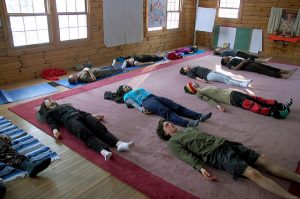Comfort food, comfort movies, comfort sex…
It’s all about comfort. For me, at least. And maybe for you. The truth is, even though I’m a novelty seeker in general, when I feel stressed or depressed, I like my comforts. I like what is familiar.

In fact, it’s one of my signals to alert me to the fact that I may be stressed or depressed. When I notice a desire to watch my favorite movie (for the 36th time), or I reach for some mashed sweet potatoes (my go-to comfort food) or I think about calling an old lover, I know my neural networks are firing in less than optimal ways. I know my brain is stressed.
When My Brain Isn’t “At Its Best”
When my brain is stressed, my neural networks fire in a way that alerts my body that things are less than well. This diverts some of the resources, a.k.a. energy that my prefrontal cortex (PFC), the “Michelle-at-her-most-awesome” part of my brain, would use and instead gives them to my limbic or survival center of my brain.
Because of course, my body in its infinite wisdom, wants me to survive above all else. Yay for survival, but what if I’m trying to move towards not just surviving, but thriving?
One of the fall outs of this is that my PFC doesn’t have the resources to function at full steam, for example to be open to new ideas or experiences, qualities I need for thriving. Another is my nervous system now seeks reassurance that things are going to be okay. It does this by relying on familiar things, things I know what to expect from. Like old movies.
I actually get a little bump of dopamine every time I expect something to happen, and it does. This is comforting.
The problem with sticking with the comfort things is that they are often unhealthy, unproductive and leave me in a rut if I rely on them too much.
There is another way though.
Neurosculpting® Yoga
Using the 5-Step Neurosculpting® Process, Neurosculpting® Yoga helps to calm the fight or flight/survival part of the brain while increasing activity and resources in the PFC. It does this all while helping your brain experience familiarity in repetitive body movements and predictable breath patterns and increases the firing of your dopamine pathways, helping you feel less stressed more quickly.

While your brain is feeling less stressed, you also get to create a new story in your mind. During the savasana (lying down at the end) part, now that your PFC activity has increased and you are more open to new ideas, a soothing guided meditation helps you connect to feelings of ease and calm that you can access in your daily life.
What if you had another way to find comfort when your brain felt stressed? What if it was one that didn’t leave you in a rut or a downward spiral, but instead spiraled you upwards towards thriving?
Here is a link to our online Neurosculpting® Yoga video. Practice alongside me for one week, and let me know how you feel!
To Thriving in Comfort,
Michelle
 Michelle Lee Weldon
Michelle Lee Weldon
Michelle is over the moon about being a Certified Neurosculpting® Facilitator. Neurosculpting® has helped Michelle to re-wire unproductive habits and ways of thinking and to discover a clearer and more integrated path in both her professional and personal life. Michelle is a Licensed Professional Counselor, Experienced-Registered Yoga Instructor and Vibrant Medicine Coach. She provides one on one Vibrant Medicine Coaching sessions which may include one or all of the following techniques: Neurosculpting® meditation sessions; Yoga Psychotherapy; EMDR techniques; guided meditation; nutrition coaching and Collaborative Medicine referrals. Michelle is the enrollment coordinator for Samadhi Center for Yoga’s 200hr Teacher Training Program and provides Yoga Based Resiliency Training workshops to medical and mental health professionals and others working in the direct care field. To see when Michelle is offering Neurosculpting® workshops near you, please visit http://VibrantMedicine.org
